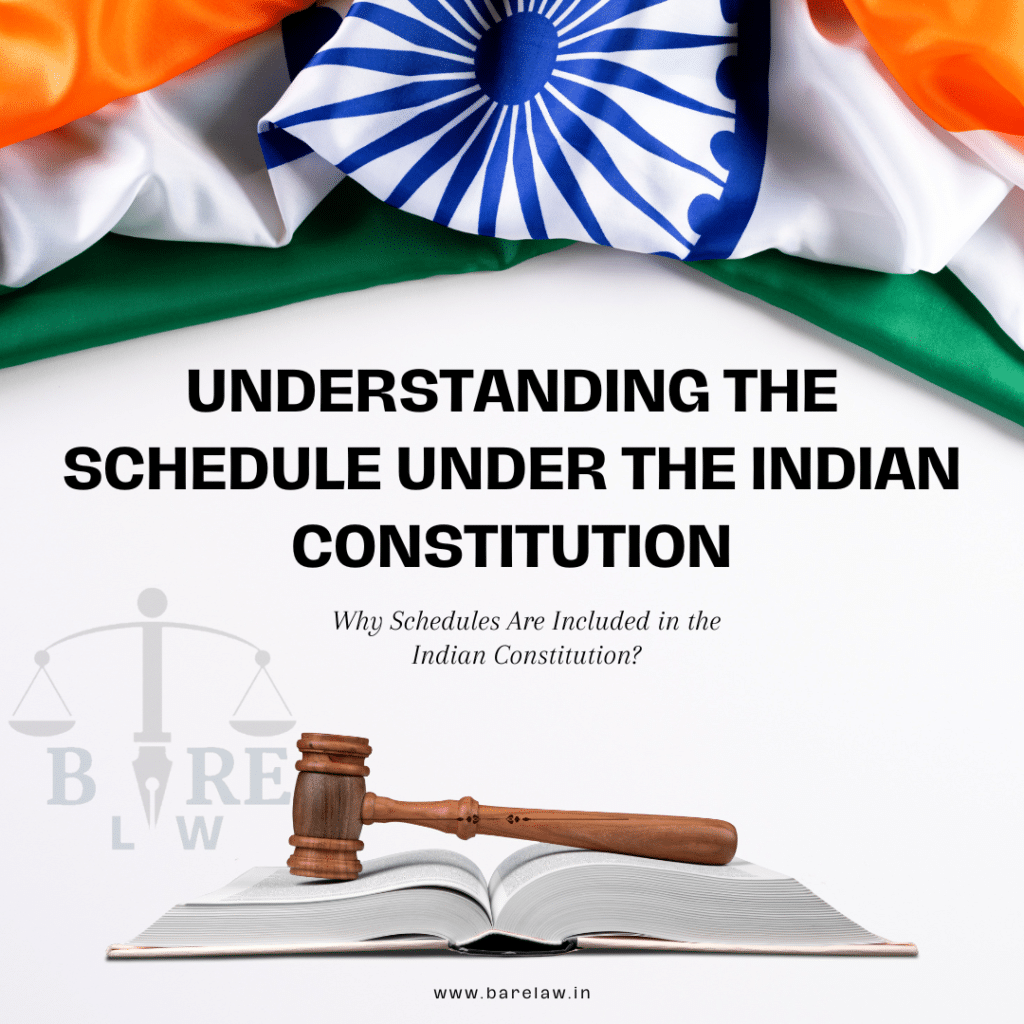
Authored By: kanika Arora
Table of Contents
Understanding the schedule under the Indian constitution
Introduction
The Indian Constitution is a legal document that covers a wide range of topics. There are 12 Schedules and 448 Articles. Tabular documentation of details not included in the Articles is what is known as a Schedule. The main purpose of schedules is to simplify the terms of an act. The main Constitution contains all pertinent information about each Act; any other information is contained in the Schedules.
Schedules were first mentioned in the Government of India Act of 1935. Then, there were ten schedules. There were eight Schedules in the final text of the Constitution, which was created in 1949. After multiple revisions, there are now 12 Schedules in all.
Why Schedules Are Included in the Indian Constitution?
- The absence of a legal component in the schedules provided in the Indian Constitution makes the provisions simple to comprehend. The clauses get shorter and less technical.
- Since the changes are organized into schedules, it is easier to update or revise the provisions of the Indian Constitution. Updates don’t require rewriting the entire article, which saves a ton of time.
- The schedule serves as a guide for other laws in addition to the Indian Constitution. There are established lists of states and union territories with the aid
- of the schedules. Lists of state and federal laws are likewise handled by the schedules.
- Numerous issues can be resolved with the use of schedules. They can be followed when further information or clarification is needed on a certain topic.
The Constitution contains these schedules; it does not contain them. As distinct documents, they remain in our constitution.
Our lengthy constitution would become more difficult to read if additional material were added to the articles. To offer more details on provisions that were left out of the articles of our Indian Constitution, schedules were written separately.
Important Elements
- The reader can more easily comprehend and evaluate the material in the Indian legislation with the help of the schedules.
- These schedules contain information that is not authorized. It’s simple to understand. It is administrative and technical.
- The act’s major text is the ideal length and size. The Indian Constitution’s schedules contain all the extra information.
- Since schedules are written independently with divisions, making adjustments or amendments to them is easier. It facilitates the modification process more easily.
- With the use of these schedules, all the extra material is integrated into the primary text.
- These schedules contain information that can be displayed in a variety of ways, including numbers, flowcharts, and graphs. This facilitates the most efficient transfer of knowledge.
List of the Indian Constitution’s Schedules
- First Schedule
The names of the states, union territories, and their corresponding territories are listed in the First Schedule of the Indian Constitution, which should be read in conjunction with Articles 1 and 2. The Union of India consists of 28 states and 8 union territories as of right now.
- The Second Schedule
The President, State governors, Speaker and Deputy Speaker of the Lok Sabha, Chairman and Deputy Chairman of the Rajya Sabha, and judges of the Supreme Court and lower courts are all covered by the Second Schedule regarding their salary and benefits. The components of it are as follows:
- Part A covers provisions for State governors and the President.
- The Speaker and Deputy Speaker of the House of People, the Chairman and Deputy Chairman of the Council of States, the Speaker and Deputy Speaker of the Legislative Assembly, and the Chairman and Deputy Chairman of a State are all covered by the provisions of Part C.
- Part D pertains to the High Court and the Supreme Court judges.
- The provisions about the Comptroller and Auditor General of India are found in Part E.
- Third Schedule
The forms of oaths or affirmations that are allowed under the Third Schedule include:
- The oath of office form for a union minister.
- Form for union ministers taking the secrecy oath.
- The oath or affirmation that a candidate for parliamentarian must make.
- A member of parliament may take an oath or make an affirmation.
- The Comptroller and Auditor General of India and the Supreme Court judges will take an oath
- or affirmation.
- Form of oath taken by a state minister in office.
- A state minister’s form of oath of secrecy.
- a pledge or declaration that a candidate for state legislature must make to be elected.
- A member of the state legislature may take an oath or affirmation.
- The High Court judges will make an oath or affirmation in this form.
- Fourth Schedule
The number of seats allotted to each state and union territory in the Council of States is specified in the Fourth Schedule.
- Fifth Schedule
The Fifth Schedule’s provisions will apply to the management and governance of scheduled areas and scheduled tribes in any state other than Assam, Meghalaya, Tripura, and Mizoram, according to Article 244(1) of the Constitution. The rules on the management and sovereignty of scheduled lands and scheduled tribes are included in the Fifth Schedule.
It is broken up into four sections:
Part A: General
It stipulates that the scheduled regions covered therein are within the state’s executive power. The governor of every State with scheduled areas must provide a report to the President about the management of those areas.
Part B: Management and Governance of Designated Regions and DesignatedTribal Groups
It stipulates that a Tribes Advisory Council must be established in every state with scheduled areas and, in states with scheduled tribes but not scheduled areas, at the president’s direction. The legislation that applies to scheduled areas is also provided for.
Part C: Allotted Regions
“Scheduled Areas” refers to locations that have been designated as such by a presidential order.
Part D: Modification of the Schedule
By passing a bill in this regard, the Parliament has the authority to amend, add to, or remove any of the provisions listed in this schedule.
- Sixth Schedule
The management of tribal territories in the States of Assam, Meghalaya, Tripura, and Mizoram is governed under the Sixth Schedule. It stipulates how tribal lands are to be administered as autonomous regions and districts. The schedule governs and administers the following tribal areas:
- Within the State of Assam
- North Cachar Hills District,
- Karbi Anglong District,
- Bodoland Territorial AreaDistrict,
- In the state of Meghalaya
- Khasi Hills District,
- Jaintia Hills District, and
- Garo Hills District
- In the state of Mizoram.
- The districts of Chakma and
- Mara
- the Lai District
- In the State of Tripura.
- The Tripura Tribal Areas District
- Seventh Schedule
Article 246 read with the Seventh Schedule of the Constitution gives the Parliament and state legislatures the authority to enact laws on any subject falling under their purview.
Three lists that address the areas of legislation are included in the Seventh
Schedule:
Union List: The Union List lists the things/subjects on which the Parliament alone can pass laws. For instance, the defense of India, the armed forces (air, sea, and land); nuclear energy; international relations; war and peace; citizenship; extradition; etc.
State List: This list includes all the topics over which the state legislature is only authorized to pass laws. Police, municipal governance, public health and sanitation, alcohol consumption while intoxicated, agriculture, water and land use, fisheries, gas and gas works, markets and fairs, etc. are a few examples.
Concurrent List: This is the third list that lists the topics on which both the state legislature and parliament have the authority to pass laws. Examples include civil procedure, evidence and oaths, contracts, trusts, actionable wrongs, criminal law and procedure, transfers of property other than agricultural land, and forests. As the name implies, concurrent legislative authority over items on the Concurrent List is shared by the state legislatures and the Union Parliament.
- Eighth Schedule
The list of languages that are recognized in India is found in the Eighth Schedule. The program currently includes 22 languages, up from the original 14 at the beginning.
These languages are:
- Assamese
- Bengali
- Dogri
- Gujarati
- Hindi
- Kannada
- Kashmiri
- Konkani
- Bodo
- Malayalam
- Manipuri
- Marathi
- Odia
- Punjabi
- Sanskrit
- Maithili
- Tamil
- Telugu
- Sindhi
- Urdu
- Nepali
- Santhali
Ninth Schedule
The Ninth Schedule’s “validation of certain acts and regulations” is outlined in Article 31B of the Constitution. Under the Constitution (First Amendment) Act of 1951, the Constitution gained a Ninth Schedule. The Ninth Schedule was added to prevent specific laws and rules from being ruled invalid because they infringe on the fundamental rights guaranteed by Part III of the Constitution. As a result, the Ninth Schedule is a list of laws that cannot be challenged in court because they infringe upon a citizen’s fundamental rights. There are currently 284 laws supplied under the Ninth Schedule, compared to the original 13 laws that it contained. The following are a few of the laws listed in the Ninth Schedule:
- 1950’s Bihar Land Reforms Act
- Act of 1948 concerning Bombay Tenancy and Agricultural Lands
- 1961’s Mysore Land Reforms Act
- The Punjab Land Tenure Security Act of 1953
- 1954’s Delhi Land Reforms Act
- A 1951 Act on Industry (Development and Regulation)
- Act of 1972 Concerning Coking Coal Mines (Nationalization)
- The Agricultural Workers Act of Kerala, 1974
- The Land Reforms Tribunal Act of 1991 for West Bengal
In the 2007 case of I.R. Coelho v. State of Tamil Nadu, the Supreme Court ruled that legislation that violates any fundamental right and is later included in the Ninth Schedule after April 24, 1973, may be challenged because it undermines the fundamental framework established by Article 21 read in conjunction with Article 14 and Article 19.
- Tenth Schedule
Disqualification on the grounds of defection is covered by the Tenth Schedule of the Constitution. The Constitution (Fifty-second Amendment) Act, 1985, popularly known as the “Anti-defection Law,” inserted the Tenth Schedule to address the problem of political defections.
According to the Constitution, if a person is prohibited from holding office under the Tenth Schedule, they cannot hold office in either the House of Parliament or the House of a State Legislature.[Article 191(2) and 102(2)]
These provisions are found in the Tenth Schedule:
- Disqualification for defection of members of State legislatures and Parliament
- Political Party members
Any member of a House representing a political party loses their eligibility to serve in the House:
- If he chooses to no longer be a member of that political party; or
- If, within 15 days following the party’s directive, he votes or abstains from voting in the House against its instructions without first receiving consent from the party, and the party does not support the action.
- Individual participants
After an election, an independent member of the House (one who was chosen without being nominated by a political party) loses his eligibility to serve in the House if he joins a political party.
- Members nominated
If a nominated member of a House joins a political party after the six-month period that ends on the day that he assumes his seat in the House, he forfeits his eligibility to serve in that body.
- Eleventh Schedule
The Eleventh Schedule, which was added to the Constitution by the Constitution (Seventy-third Amendment) Act, 1992, addresses the duties, jurisdiction, and capabilities of Panchayats. It includes 29 panchayat-functioning items, some of which are listed below:
- Agriculture
- Soil conservation, land consolidation, land reform implementation, and land improvement
- Watershed development, water management, and light irrigation
- Dairy, poultry, and animal husbandry
- Fishing
- unconventional sources of energy
- programs aimed at reducing poverty
- Instruction, encompassing elementary and secondary learning
- Vocational education and technical training
- Non-formal and adult education
- Libraries
- Cultural pursuits
- Fairs and markets
- Sanitation and health, including clinics, hospitals, and primary health centers
Twelfth Schedule
The municipalities’ duties, authority, and powers are outlined in the Twelfth Schedule. The Constitution (Seventy-third Amendment) Act of 1992 also added it. It includes the following eighteen municipally functioning items:
- Town planning is a part of urban planning.
- Control over building construction and land use.
- arranging for the social and economic advancement.
- bridges and roads.
- provision of water for business, industrial, and residential uses.
- Solid waste management, sanitation conservation, and public health.
- fire department services.
- urban forestry, environmental preservation, and the advancement ofecological principles.
- defending the rights of the less fortunate members of society, such as the mentally
- ill and disabled.
- Slum modernization and enhancement.
- reduction of urban poverty.
- the provision of urban facilities and amenities including playgrounds, gardens, and parks.
- promotion of artistic, educational, and cultural elements.
- Graves and funeral homes; cremations and funeral homes; electric crematoriums.
- pounds for cattle; stopping animal abuse.
- vital statistics, such as birth and death registrations.
- Street lighting, parking spaces, bus stations, and public restrooms are examplesof public amenities.
- Control of tanneries and slaughterhouses.
Conclusion
The Indian Constitution is made clearer by the use of schedules. An assortment of laws make use of them. In all, twelve schedules are present. Not included in the articles of the constitution, it contains additional information.





